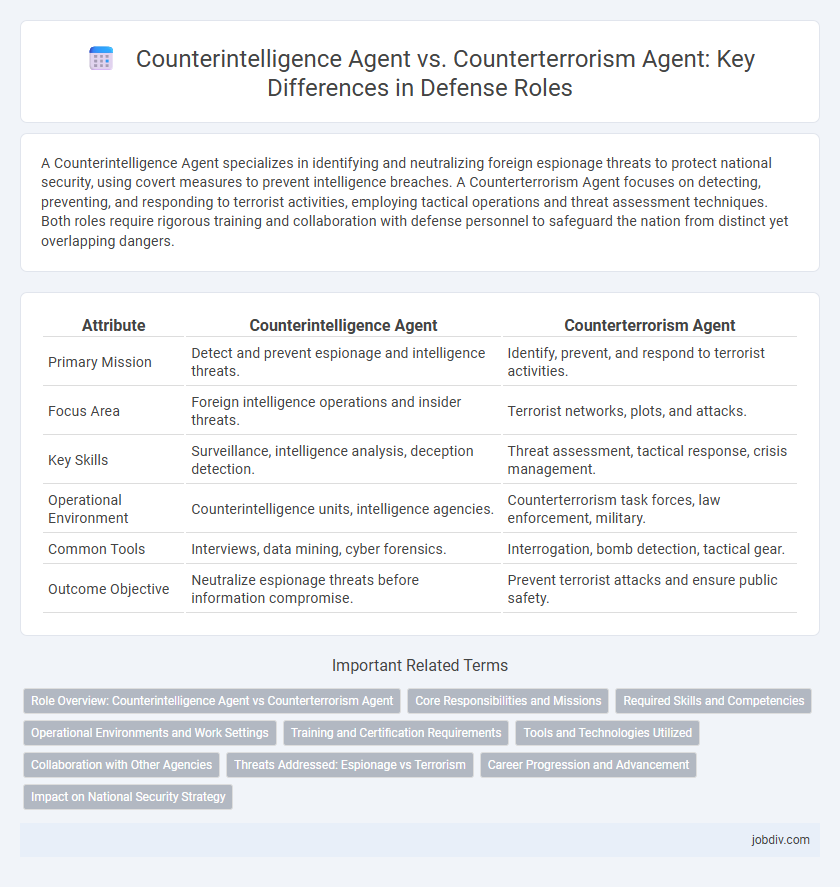A Counterintelligence Agent specializes in identifying and neutralizing foreign espionage threats to protect national security, using covert measures to prevent intelligence breaches. A Counterterrorism Agent focuses on detecting, preventing, and responding to terrorist activities, employing tactical operations and threat assessment techniques. Both roles require rigorous training and collaboration with defense personnel to safeguard the nation from distinct yet overlapping dangers.
Table of Comparison
| Attribute | Counterintelligence Agent | Counterterrorism Agent |
|---|---|---|
| Primary Mission | Detect and prevent espionage and intelligence threats. | Identify, prevent, and respond to terrorist activities. |
| Focus Area | Foreign intelligence operations and insider threats. | Terrorist networks, plots, and attacks. |
| Key Skills | Surveillance, intelligence analysis, deception detection. | Threat assessment, tactical response, crisis management. |
| Operational Environment | Counterintelligence units, intelligence agencies. | Counterterrorism task forces, law enforcement, military. |
| Common Tools | Interviews, data mining, cyber forensics. | Interrogation, bomb detection, tactical gear. |
| Outcome Objective | Neutralize espionage threats before information compromise. | Prevent terrorist attacks and ensure public safety. |
Role Overview: Counterintelligence Agent vs Counterterrorism Agent
A Counterintelligence Agent specializes in identifying and neutralizing threats posed by foreign intelligence services, focusing on protecting classified information and preventing espionage activities. In contrast, a Counterterrorism Agent is dedicated to detecting, preventing, and responding to terrorist threats and attacks, often collaborating with law enforcement and military units to safeguard public safety. Both roles require expertise in intelligence analysis, surveillance, and threat assessment, but their operational focus and mission objectives differ significantly within the defense sector.
Core Responsibilities and Missions
Counterintelligence agents primarily focus on identifying, monitoring, and neutralizing foreign espionage threats to protect national security secrets and intelligence assets. Counterterrorism agents concentrate on preventing, investigating, and responding to terrorist activities by disrupting plots and dismantling terrorist networks. Both roles require rigorous intelligence analysis, but counterintelligence emphasizes safeguarding information from adversaries while counterterrorism prioritizes proactive threat intervention and crisis response.
Required Skills and Competencies
Counterintelligence agents require advanced skills in surveillance, analysis, and knowledge of foreign intelligence operations to detect and prevent espionage activities. Counterterrorism agents must possess expertise in threat assessment, rapid response tactics, and crisis management to effectively neutralize terrorist threats and protect public safety. Both roles demand strong critical thinking, communication abilities, and proficiency in gathering and interpreting intelligence data under high-pressure conditions.
Operational Environments and Work Settings
Counterintelligence agents primarily operate within intelligence agencies, military environments, and government facilities, focusing on detecting and preventing espionage, sabotage, and insider threats. Counterterrorism agents work in diverse settings such as urban hotspots, airports, border areas, and conflict zones, where they actively respond to and prevent terrorist activities. Both roles require collaboration with law enforcement, military units, and international partners, but their operational environments differ based on mission scope and threat focus.
Training and Certification Requirements
Counterintelligence agents undergo specialized training in espionage detection, surveillance techniques, and cybersecurity, typically requiring completion of programs offered by agencies such as the FBI or CIA, along with security clearance certifications. Counterterrorism agents focus on skills related to threat assessment, crisis response, and tactical operations, often receiving training at institutions like the National Counterterrorism Center and obtaining certifications in emergency management and tactical combat. Both roles necessitate continuous education and recertification to stay current with evolving threats and intelligence methodologies.
Tools and Technologies Utilized
Counterintelligence agents employ advanced surveillance systems, signal intercept technologies, and secure communication tools to detect and neutralize espionage threats, utilizing software for data analysis and cryptographic applications to safeguard sensitive information. Counterterrorism agents rely heavily on geospatial intelligence, biometric databases, and explosive detection devices, integrating real-time monitoring systems and drone reconnaissance to prevent and respond to terror activities. Both agents leverage artificial intelligence and machine learning platforms to analyze threats, but their tools are tailored to distinct operational focuses: counterintelligence prioritizes covert information protection, whereas counterterrorism emphasizes rapid threat identification and neutralization.
Collaboration with Other Agencies
Counterintelligence agents collaborate closely with agencies such as the FBI, NSA, and DIA to identify and neutralize espionage threats, sharing classified intelligence and leveraging joint surveillance operations. Counterterrorism agents work alongside local law enforcement, the Department of Homeland Security, and international partners to prevent and respond to terrorist activities through coordinated intelligence sharing and rapid information dissemination. Both agents rely on interoperable communication platforms and unified command structures to enhance the effectiveness of multi-agency counter-threat initiatives.
Threats Addressed: Espionage vs Terrorism
Counterintelligence agents specialize in identifying, preventing, and neutralizing espionage activities by foreign intelligence services, safeguarding classified information and national security secrets. Counterterrorism agents focus on detecting, disrupting, and responding to terrorist threats and attacks, aiming to protect civilian populations and critical infrastructure from violence. Both roles involve threat assessment and intelligence gathering but differ fundamentally in addressing espionage versus terrorism to mitigate distinct risks.
Career Progression and Advancement
Counterintelligence agents often advance by developing expertise in espionage detection, cybersecurity, and political threat analysis, frequently moving into supervisory roles within intelligence agencies or specialized government units. Counterterrorism agents progress through operational experience in threat response, tactical planning, and interagency coordination, with career advancements leading to leadership positions in federal task forces or homeland security divisions. Both career paths demand continuous training and adaptability to evolving threats, with higher-ranking roles emphasizing strategic planning and intelligence integration.
Impact on National Security Strategy
Counterintelligence agents protect national security by identifying and neutralizing foreign intelligence threats, preventing espionage, and safeguarding classified information critical to strategic defense initiatives. Counterterrorism agents focus on preventing, responding to, and mitigating terrorist attacks that can destabilize national infrastructures, disrupt socio-political order, and cause mass casualties. Both roles are essential in shaping a comprehensive national security strategy by addressing distinct but complementary threats to the nation's safety and sovereignty.
Counterintelligence Agent vs Counterterrorism Agent Infographic

 jobdiv.com
jobdiv.com